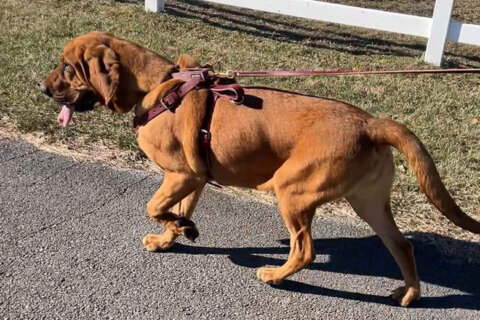WASHINGTON — A lifesaving medication that counteracts the effects of a drug overdose is now in the hands of more local police officers.
On Monday night, 40 officers from the Montgomery County Police Department, the sheriff’s office, the City of Rockville and Chevy Chase Village were trained and equipped with Naloxone, also known as Narcan. In all, about 90 police officers will complete the program by the end of the year.
Montgomery County began the Naloxone training pilot program last year after seeing opioid-related overdoses spike nationally in recent years. Since then, Montgomery County police officers have administered Naloxone four times. All four overdose victims survived.
The county’s Health and Human Services Department provides two doses of the drug to certified police officers.
“The officers learn a little about the fundamentals of addiction, how Naloxone works in the system and how to actually administer the antidote to the victim,” says county police officer Scott Davis, coordinator of the department’s crisis intervention team.
Naloxone is delivered as a nasal spray through an atomizer attached to a syringe. For officers, the medication is stored in bright yellow Pelican Products Inc. cases that stabilize the temperature and protect the vials from becoming damaged.
“You could literally run over the case and it won’t break,” Davis says.
If administered within the first minutes of a suspected overdose, Naloxone can save someone’s life.
When a person overdoses on an opioid such as heroin, the opiate receptors in the brain start shutting down.
“Quite frankly, time counts when you overdose,” Davis says. “Somebody stops breathing, then they go into full cardiac arrest, and then they’re gone. Narcan does a very good job of bringing them directly out.”
Both Maryland and Virginia passed legislation last year that expanded the public’s access to Naloxone. A resident can walk into a pharmacy without a prescription and receive the lifesaving medication. The D.C. Council is considering a similar bill.
There has been a sharp rise in opioid overdose deaths in the U.S. since 2000 and the number has nearly tripled since 2010.
“Over the last couple years, we’re starting to see a shift from prescription medication abuse to actually illicit drugs,” Davis says.
Law enforcement officials say some people become addicted to prescription painkillers, such as hydrocodone or oxycodone. When the prescription runs out or becomes too expensive, addicts turn to heroin, a cheaper and more accessible drug.
But too often, the results are deadly. Heroin is much more potent than it was 40 years ago. Purity levels have jumped from about 5 percent in the 1970s to about 90 percent today. The purity is so high that addicts no longer have to inject themselves to get high — they can simply snort it.
Narcotics detectives say the inexpensive cost and availability of heroin, combined with a record number of prescriptions, drives the increase in opioid overdoses.
“The DEA is getting smarter. They’re making the pills harder to pulverize,” Davis says. “They’re making them like a time-release capsule, where it’s harder to process that in a sniffable form.”
If you are dealing with a drug addiction, Davis says, reach out and ask for help.
“I think it’s a very positive thing for us to be able to respond to a scene and give somebody the antidote to save their lives. Maybe they’ll look at police in a different way.”







